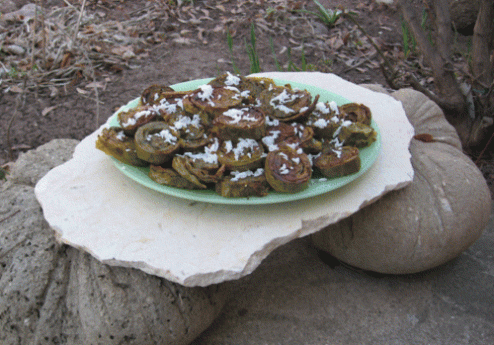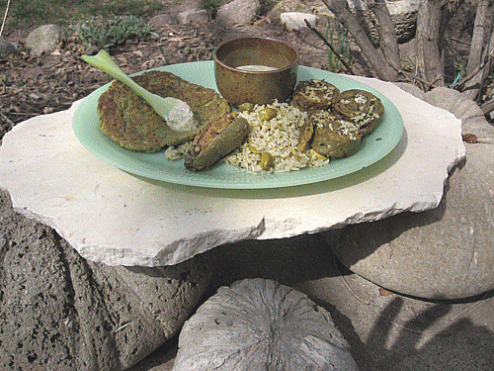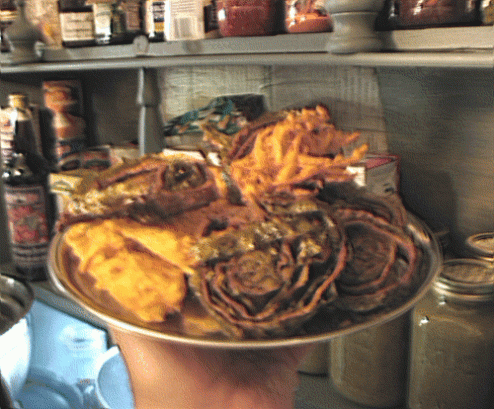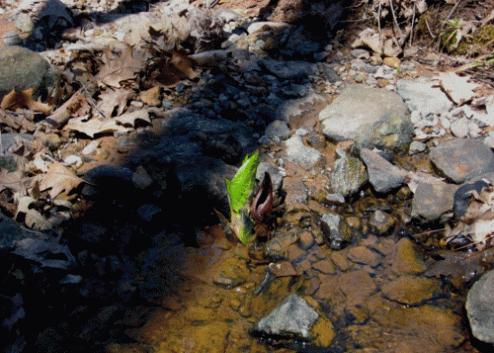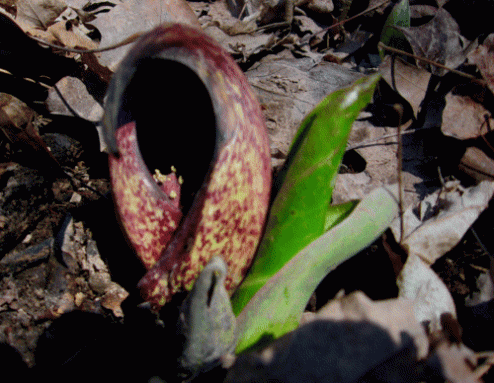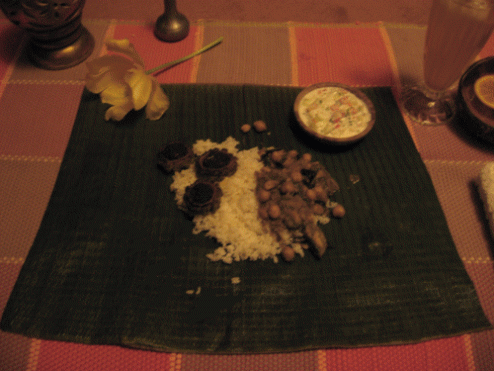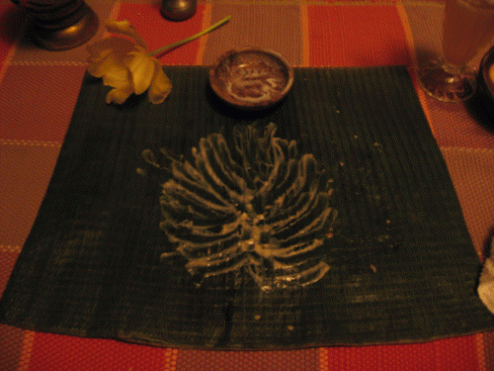Patra Bajia (stuffed arbi/colocasia/taro leaves) begins the quadrille
“…the leaves contain needle-shaped oxylate crystals that can cause a stinging sensation in the mouth and throat when not properly prepared… ” How nice….that makes me want to dive right in to a plateful….
The truth is, I’ve already eaten arbi leaves…
A few years ago, as I was wandering through the aisles of the nearest Indian grocer, I happened upon a can of them, already seasoned, rolled, cooked and sliced, and, as I had no idea what they were, I naturally placed the can in my basket. Upon arriving home, I tucked it away in a corner of the cabinet. When an inquisitive moment paired with a driving need to exoticly-impress a date finally came, I was pleasantly suprised to see whorls of green layered with gold! I removed them as carefully as I could, but as some of you may already know, it is inevitable that a fair portion of these canned goodies will break. However, whole or broken, the taste was unforgettable: rich, dark greens layered with besan, roasted and infused with an unfamiliar formula of spices, fragrant from re-heating in the microwave oven… for Umrikans this will more-than-suffice for exotic. The date? Well… I could tell by the way his mouth fearfully avoided the morsels as he chewed and swallowed that he was far from feeling fond affection; still, he inspected each piece carefully, turning them this way and that with his fork, his head cocked first one way and then the other in a not-so-subtle attempt to understand and unravel their mysterious aesthetic. I had no explanation to offer, just: “…more chutney?”.
Sometimes, that’s the only way to taste new things in Umrika-land… I looked for them on my next curry leaf run, but it appeared that there was a greater demand for bags of dry, crunchy chaat mixes as these now hung off the corners on clips, filling the entire section, obviously having overgrown their former territory like potted mint will try to do if left unchecked. I passed up the frozen parathas, the pathetic kerelas and left the store with my new stash of kari-patta. Instead of cash, I should have searched my trunk and produced a pair of pruning shears for trade…add another hefty item to my expanding list of “things that I must buy online…” (I grumble much more about the sudden, much-more-local loss of Jyoti karhi and dhal makhani, but I’m keeping my chin up, and mouth open for things to come).
Luckily, recipes for these exquisite, intricate-looking rolls abound in food-blog land. And it isn’t just besan finding its way between the leaves: rice, coconut, and Aunt Karisma’s undies show up in recipes that stretch like crackled elastic from Uttar to Andhra Pradesh. I, however, decided to start my tasting taut and twangy in the sweet-sour state of Gujerat, and collected nine different recipes of similar sort to contrast, compare, calculate and finally arrive at a recipe indicative of the Gujerati opus but without any particular credit in owe.
Unfortunately I was missing just one, perhaps important, ingredient for my recipe: the arbi leaves. I don’t expect to see them for sale anytime soon, or anywhere nearby. That very nice man from Delhi has a hard-enough time stocking usable tendli, let alone leaves that would never make the menu of the restaurant next door. This summer I’ll grow my own, and post the results if I’m able to speak after the first bite. Collard greens are plentiful here and make a fair substitute.
Oh, and just for trivial thrills, there are dishes made from the leaves which do not contain a souring agent; apparantly the taro plant(the accepted Umrikani apellation) is crucial to the cuisine of Hawaii, and other Pacific island cultures; for now though, I’d like to play it safe.* (A tip from Vee of Past, Present and Me: break the stem of an arbi leaf you intend to use, rub the juice on your inner wrist and count to ten; if it stings, the oxylate concentration is too high. Don’t use them. Take it as an omen that you’ve been cooking too much and take the afternoon off from the kitchen. Order out for pizza.)**
Patra Bajia
The multiple steps involved in preparing these may seem daunting, but actually it’s quite easy; you can even do as I did and start a day ahead of serving, casually doing each step when you have time.
18 arbi leaves
2 1/2 C besan
2 t ground dry red chiles (more or less to taste; I used more)
1 t turmeric
3 t sugar or gur
salt to taste
3 T oil
1/2 C tamarind paste/extract
3 t ginger paste
water
1 bunch of coriander leaves, finely chopped
1)Trim stems from arbi leaves, wash well and pat dry. Carefully slice off the thick center rib of each leaf, taking care that you don’t split them in the process (it happens though- hide these in the middle of the rolls; know one will be the wiser). Place each leaf on a board and gently roll it over with a rolling pin, again being careful not to split the leaves.
2)Divide the leaves by similar size into groups of three.
3)Mix the besan, ground chiles, turmeric, sugar and salt. Add the oil and mix well by hand until the mixture resembles crumbs.
4)Add the tamarind paste, ginger paste and enough water to form a thick, but easily spreadable paste (like peanut butter or yoghurt cheese). Add the coriander leaves and mix well. Check for salt.
5)Taking the groups of leaves in turn, ribbed sides facing up, spread the paste thinly( if you think of it more as an adhesive than a substantial filling, you’ll do fine…in fact, you should be able to adhere them securely to the walls of your kitchen, should you be so moved…) on each of them, placing the next leaf on top of the previous one before spreading the next layer of paste. So, you will have the following configuration: leaf, paste, leaf, paste, leaf, paste. When three have been layered and pasted, and with the tip of the leaves toward you, fold 1-2″ of the sides toward the center, and then roll firmly starting from the leaf tips to the stem end. Secure the rolls with cotton string (if you wish, or just place it seam-side down) and place in the container of a steaming apparatus. Steam for 40 minutes. Allow the rolls to cool before handling.
6)Now, take each roll, remove the string, and slice crossways carefully, using a sharp knife, into 1/3-1/2″ slices. These may be eaten just as they are with relishes, but most often they are finished with a tempering, such as the following, or deep-fried. I decided to take the middle road:
For the tempering:
3 T oil (if you would like to drizzle or toss them with oil, then use this amount, if you would like to shallow-fry them, use 5-6 T, adding more if necessary)
2 t mustard seeds
2 t cumin seeds
2 t sesame seeds
2 pinches of asafoetida/ hing
1a)Heat oil over med-low heat, add mustard, cumin and sesame seeds; when the mustard seeds splutter, add the hing, swirl and then pour over the sliced rolls. Toss gently to coat if you wish.
1b)If you would like to shallow-fry these, then place a cover on the pan when the seeds begin to splutter and allow them to finish. Remove from heat, and then remove the fried seeds with a spoon. Set these aside. Return the oil to heat and fry the slices on each side until golden brown, adding a little more oil if necessary.
2)In either case, sprinkle them with 3-4 T grated coconut and serve.
If you decided to shallow fry them and still have the reserved fried spices, take them and follow me…
Pel’s Quick-and-easy Pistachio Pilaf
oil
1/2 C grated coconut, fresh or frozen
the fried spices from the previous recipe
a handful of shelled, roasted pistachios (soaked and skinned as well, if desired)
2 C dry, pilaf-making rice, rinsed well and drained (I tried sona masoori- it worked)
3 1/2 C water
3/8 C coriander-mint chutney (coriander and mint leaves, lime juice, salt, ground roasted cumin)
salt to taste
1)Wipe the inner surface of the pan with oil and roast the coconut until very lightly golden over a low flame, add the fried spices, pistachios and a little oil and fry for about 1-2 minutes, stirring constantly to avoid any scorching; add the drained rice and mix very well- about 2 minutes more.
2)Add the water, chutney and salt to taste (I used 1/2 t, but it depends on the saltiness of the chutney); Bring to boil, cover with a tight-fitting lid, turn heat to low and steam for 20 min. Lift lid and fluff with form, re-cover and let stand for a few minutes.
I needed a dish made of pulses next, so, going with the green theme and the Gujerati flavour, I took this recipe straight out of Madhur Jaffrey’s World-of-the-East Vegetarian Cooking:
Moong Dhal Na Poora
1 C moong dhal (I used dhal with skin for extra colour and nutrients)
3/4″ piece of ginger, peeled, sliced
3 cloves of garlic, peeled
1-2 fresh green chiles, cut into 3 pieces
1 t salt, or to taste
1/4 t baking soda (optional…I didn’t use)
1/4 t turmeric
2 T coriander leaves, minced finely
1 small onion, peeled and minced finely
about 1/2 c oil/ghee (I used peanut oil)
1) Pick over the dhal and rinse well; soak in plenty of water for 5 hours; drain.
2)Make a paste or puree of the ginger, garlic and chiles. Grind it with the dhal, adding 1/2 c of water, the salt, baking soda, and turmeric until you have a thick batter. Stir in the onions and coriander leaves.
3)Heat a tava or griddle over medium-low heat; for each poora: drop a teaspoon of oil on the cooking surface, tilt to spread; place 1/3 c of the batter in the center, count to 4, and then with a small ladle or spoon spread the batter by swirling it outward from the center in a spiral, aiming for a 5-6″ circumference; drizzle 1/2 t of oil over the poora surface, and another 1/2 t at the edges; cover and allow to cook for about 2 minutes, or until the underside has a reddish tinge. Flip the poora to the other side, and allow to cook uncovered for about 1 1/2 minutes, until it develops reddish spots.
4)Make all of them this way, stacking them on top of each other. Be sure to stir the batter in the bowl well before each one is made.
Then, I really needed something special to moisten all of this dryness. Anita’s very delicious and very versatile Walnut and Mint Chutney(of A Mad Tea Party) seemed like the answer -and it was!…. except I used pistachios… which she said is just fine….
I know that you might have an urge to add a bit of garlic or ginger or temper-of-hing to this, but don’t! The Kashmiri Pandit Chutney Patrol (KPCP)will come after you if you do!!!!
If you are feeling really fancy, you can make little spoons of celery-sticks, like I did!! 😀
(Ooops! It looks like a Marathi specialty wanted to sneak into the post too… oh well!)
I had a few of the patra bajia left over a fter a few days, and as I was making sweet-cassava pakoras for some company and had hot oil at the ready, I decided to deep-fry some of them as well…. Although I was at first dismayed watching my hard-earned spirals unravel in the oil, the final effect is astoundingly beautiful: a bit like mini-galaxies….
(that’s a lousy photo… make them and see for yourself! They are very crispy… and remain crispy for a looooong time…)
This is my entry to Jihva for Ingredients- Greens, May 2007, hosted by Indira of Mahanandi, co-hosted by Nandita of Saffron Trail. This month’s JFI marks the one-year anniversary of this Indian food-blogging event. May it continue for a hundred more!
“Oxalic acid may be present in the corm and especially in the leaf, and these foods should be eaten with milk or other foods rich in calcium so as to remove the risks posed by ingesting the free oxalic radical especially for people with kidney disorders, gout, or rheumatoid arthritis. Calcium reacts with the oxalate to form calcium oxalate which is very insoluble.” (Wikipedia, the full entry can be read here)
**Pel may have added that last part… 🙂 But in consolation, a concisely-written page about taro may be found here.
On a Skunk Cabbage Hunt…
This post is not a recipe, nor do I believe it has anything to do with gastronomic delights; however, I believe that the eyes need food of a special kind, so I share this with you!
Years ago, when my sister and I were growing up, our parents maintained a summer/vacation home about 45 minutes north of Green Bay. Although it was one of the first things to be sold and divided upon their divorce in our early twenties, I must say that it is missed very much still by both of us. The land was given to my parents by my maternal grandparents, and was just a small corner of the several hundred acres that they owned: some of it farmland, and the remainder fully wooded. During the summer, while we were on vacation from school in the city, we spent most of these warm days living there, my father joining us on weekends. Not only was it wonderful to be so near to our grandparents, (my grandmother being a wonderful cook and gardener of German heritage who taught and inspired me in many ways), but, for me, to be often within the immense forest that lay beyond the edges of the rows of corn. Our cottage stood at the gate between these two worlds, and I passed freely from one to the other.
During these solitary wanderings, I developed a great devotion and respect for nature that, I think, no school could ever accomplish. I was most fascinated by wild plants, and owned, at the time, two handy guidebooks for identifying them that I keep to this day. In fact, back then I would not leave the house without them at my side, so, each time we ventured up there, into the a small suitcase they went, along with a slew of other reading material, and, with freshly-cleaned eye-glasses perched proudly on my nose, and my sister with her collection of crew-cut Barbie’s, we all took off with our mother in our 1970’s Ford station-wagon, to stay at the cottage for a week or more at a time.
Within a few years, I knew every inch of ground within a half-mile radius of the cottage, which was sat on higher land and was accessed by a gravel-and-dirt road which ran along the corn fields from the main road. Surrounding two sides of the cottage was a dense stand of cedar trees, and beyond this the land rose higher until the trees parted to expose a clearing where milkweed, wild raspberries, black-eyed susans, and phlox grew. I liked to stop here for a bit: to tie my shoes or clean my glasses, to watch the sunbeams play lazily over the butterflies that gaily fluttered from flower to flower, or maybe to ponder a while. On the side opposite from where I’d emerge, the woods began again, here were deer paths that ran away from the clearing. They were easy to follow, and sloped steadily downward as they went onward and became cool and moist underfoot. New, strange plants emerged from the undergrowth here, the familiar plants of the meadows and roadsides becoming sparser, the dark, black earth more visible, until, if one dared go this far as I did, a glorious, shining, greener-than green sight appeared ahead: mosses covering rotting logs that criss-crossed in every way, forming a soft, crumbling matrix that exposed a pool of green water beneath. It wasn’t until I had obtained a pair of water-proof rubber boots that I could venture beyond vision into union with this place.
The mosquitos would have been absolutely unbearable without a spray-on repellent; still, they managed to follow me like tiny, watchful guardians as I explored. Spiders hang webs here wherever they can to catch this flying feast. To move from the still quietness of the drier part of the woods to this, seems like coming upon a secret caterwauling party in the middle of nowhere. Besides the constant humming of the mosquitos and flies, there were birds that darted and twittered, and frogs that leaped without warning and grew fat on easy meals. It is impossible in all of this activity, not to notice a large, noble plant with splaying green-yellow leaves the size of dinner-plates that grows here in this hidden chartreuse world- and not beyond it… They can’t be mistaken for anything but the peaceful rulers, keeping some sort of arcane order and solemnly praising the filtered green light that pierces this cloistered place and reflects from the pool back upward to make them glow all the more vividly from my shadowed view-point. It wasn’t until a few years later, during a summer workshop course in forest management, that I learnt of their common name: skunk cabbage.
They aren’t related to cabbages at all, in fact, they are related closely to arbi…..(“taro” as we in the states know them), and like them, are a member of the family Araceae- the Arum family. This particular plant is the only member of its genus, and is one of the oddest of plants in a family of odd plants. It flowers in early spring, before other plants have begun to grow, and even before it’s own leaves appear. Though the plant itself, at the height of summer, is not easily missed I can assure you, these early, short-lived blooms are known to very few who tread in wild places. The plant has the ability to raise its own temerature higher than that of the surrounding air, and in this way, is able to melt the layer of ice and snow above its roots to emerge and, with it’s single, maroon, hood-like flower, to lure carrion-feeding insects into it’s warm interior for fertilization. The whole plant exudes an odour not unlike garlic or hing when torn or crushed, and it is this that gives the plant its common name. Unfortunately, because the plant also has an extremely high concentration of oxalyte crystals- far, far more than the taro- the leaves must be air-dried for six months before it can be consumed; cooking the leaves thoroughly is not enough to neutralize this property, which, according to one wild-plant forager in re-telling his younger days, (when he added minced leaves to a pot of chile con carne and put it to simmer), caused an unbearable stinging sensation that had him rinsing his mouth for over a half-hour!
Edibility aside, the surreal blooming of a colony of skunk cabbages is a rare sight, and one that I have not witnessed in many years. Therefore, over this past weekend, I decided to wander about a nearby county park where, over the past summer, I had noted a few extremely sparse colonies of this amazing species of flora. I had to do a bit of searching through the low grounds of this gully-and-creek-divided park, but, in the end, I was not in the least bit disappointed for my snooping!
To any readers that got this far: [sung in my best Marilyn Monroe voice] Hhhappy Earth Day….. to you…hhappy earth daaaay…tooooooo yooooooou…..hhhaappy eeeaarrrrtttthhh daaaaay….terra firma……..Happy Earth Day, to you….
Maiyya Yashoda from Hum Saath-Saath Hain…
I decided to check out youtube to see if someone had posted this dance and song number from this movie that, as readers from my last post will know, I remember so well from when I was younger… 😀
OMG I LOVE IT!!! Any one who disagrees simply hasn’t developed taste yet! Oh well!
Oh!!!! This one too! :
Yep! Karisma Kapoor AND Aishwariya Rai are my new iconS… [do sashtaang pranam!]
In honor of the occasion, my cats brought me this gift early this morning….
Toro Bravo
My mother loves to vacation in Mexico. From autumn to spring, Wisconsin can be a bit chilly, and a bit gloomy, which is fine for some- even I don’t mind it so much- but my mother is one of those people who would be happy with sunshine and summer every day. So, at least twice a year, she packs her bags, makes arrangements online, and, after a send-off dinner with the family and a few pecks on our cheeks, she’s off to sun-bathing and margaritas…
She and her sister, my aunt, are there right now… and this is what made me think back to about 4 years ago, when my mother made a special announcement to our family: she had decided to take a group of people to Mexico with her. This group was to be composed of her best friend, my sister and her husband, and me, and, as I was single at the time, I was allowed to choose one of my friends to join us. What a Christmas present eh?! Flight and hotel arrangements were made, vacation times were correlated and approved, and the six of us packed our bags and found ourselves in Puerto Vallarta for a week. All memory of the piles of ice and snow and spine-chilling winds we had come from melted in the warm, humid weather, the kaleidescope of flowers that bloomed everywhere, the rushing wings of birds, the people who lazily dawdled through the streets of the city and basked in sunlight on the beach.
And to think I almost didn’t go! I was nursing a badly-broken heart at the time. I was truly miserable, and found myself having to piece my self and my life back together again at the sudden demise of a seven-year relationship. Posessions had to be divided, new living arrangements made, goodbyes that needed saying were better left unsaid. My family insisted that the trip would be good for me…just to get away from everything….just for a few days… Finally, and a bit unwillingly, I succumbed… but what possible fun could I have feeling like this?
Puerto Vallarta is steeped in a bit of history, and a bit of mystery as well. It was not always known by its current name, nor was it always a popular vacation spot. What it is would be hard to describe to someone who has never been there, but I think magical… romantic… with a touch of a masquerade thrown in would do it justice. What struck me first was that I was suddenly a bit wealthier because of the exchange rate; 200 pesos (about 20 U.S. dollars) could go quite a ways… and I don’t know exactly why, but, after a day or so I became intensely aware of how rude and snobbish many other vacationing Americans were behaving to the hotel staff, taxi drivers and anyone else in a position of servitude. I honestly felt embarrassed to be associated with them in any way. I began to spend most of my days away from the hotel, taking a taxi downtown to wander the shop-lined streets (my American friend often joining me), and then a few paces furthur to what lay beyond. As I walked along, I kept saying to myself, “I have seen many chickens in my lifetime, but this is something entirely new to me…”
When night falls there, it is ushered in by a swirl of colour and a parting nod from the sun. The city seems to shift gears and transform into a festive, lamp-lit celebration that doesn’t end until the sun returns. My friend and I found a comfortable and welcoming place to loosen our buttons and mingle a bit. It was called Paco Paco, and if I were to tell of all those tales, secrets stolen from under its sheltering roof, from under its roofless patio in the sky, spied upon only by a veil of glittering stars and a moon that wanders by, I would do a great disservice to you, as they alone would fill up many pages. In the light of day, the streets are swept. Chickens peck busily at crumbs. No trace remains.
I made a few good friends there. The best goes by Gonzo. When I knew him back then, he lived humbly and frugally in an old and crumbling hostel. He taught me just enough Spanish to be a little witty; his English was near-perfect; his knowledge of Mexican cocktails and the art of living beyond failed love, superb. He and I spent many hours chatting, laughing and sipping under the roof of Paco Paco. In my fleeting memory I can hear the latin-tinged, then-latest disco songs throbbing beneath us, I can see the two of us wandering room to room along narrow stair-cases that would make an American building inspector shudder. We took turns buying each other rounds of drinks, and this particular one he ordered, thinking of me and how I love black russians… just to cheer me up. He did.
Toro Bravo
1 1/2 oz. tequila
1 oz. coffee-flavoured liqueur, such as Kahlua
ice, coarsely crushed or cubes
half of a lime
1) Fill a medium-sized tumbler (old-fashioned glass) nearly to the top with ice.
2)Pour into it the tequila and coffee liqueur; mix gently.
3)Squeeze the lime over the top- discard, and serve.
I was told by Gonzo that this is to be drunk in one swallow like a shot…however, he may have been trying to get me drunk. I recommend sipping it slowly as an after-dinner drink or three.
NOTE: This is one of two variations I found for this authentic Mexican drink, and it is the one I remember. The other way is to use equal parts of tequila and Kahlua(or other coffee liqueur), but I find this cloyingly sweet. There are north-of-the-border versions of this as well made with equal parts tequila, Kahlua and vodka…with or without the lime juice; some of them are also shaken with ice and strained into a glass like a martini. I urge you to try the recipe above before any others.
ANOTHER NOTE: The last time he and I communicated, he delivered great news to me: he and a friend had opened up a pastry and coffee shop! Besides pastel de tres leches, and pastel de chocolate(3-milk cake and chocolate cake, respectively), he informed me of the delicious carrot cake they also serve! I had no idea…! It’s too bad that my mother doesn’t speak any Spanish, save margarita and cervesa; I would ask her to locate his shop to stop by and give my regards… Oh, well…
Soyi bahjill chane gashi (chick-peas in roasted coconut gravy) + Stuffed Bitter-gourds I (Konkani? Tamil?)
I’ll admit this to all of you: my absolute favorite legume/pulse is channa, AKA gram, chole, garbanzo bean, chick-pea……kabuli or badi/kala…..and also known as many, many other names around the world, but I know it as delicious!
Over the years, I have tried several recipes of Indian origin, most of them Punjabi. I can’t blame them for their fondness, no….not at all! And while I find great pleasure in devouring these near-spherical wonders in rich browned onion and tomato or tamarind sauces, I found myself yearning for something new, something that I hadn’t yet found, and yet steeped in a long tradition that had as yet not revealed itself to me. That is, until a few days ago, when I happened upon a very intriguing recipe hidden in the folds of Manjula’s marvelous collection of Konkani recipes, Daalitoy.
I think what intrigued me most while reading over her recipe, besides the lush coconut, red chile, and tamarind- based gravy, was the very subtle use of lightly-roasted methi seeds to add an almost imperceptible note within the layers of flavour. Manjula described two ways of making this dish: the first was with fresh, unroasted coconut and the use of methi made optional. As I tend to welcome a bit of luxury and greater complexity in flavour, I opted to prepare what she described as “a special variation of chane gashi” made with roasted coconut called soyi bahjill chane gashi.
Let me tell you now, I was not disappointed! This dish, because of the complex aromatics released while roasting not only the coconut, but the chiles and methi as well, and also added to this the final tadke with its bounty of curry leaves, will literally bask your olfactory senses in sheer delight! Such a few, simple ingredients made into perfection! And look, I haven’t even mentioned the chick-peas since I began. It’s that good.
This dish is traditionally prepared with the addition of a mild-flavoured, starchy vegetable that soaks up the delicious gravy like a sponge. She strongly recommends green jackfruit (fresh or tinned) if you have access; I opted for one of the other three that she mentioned: green banana (such as unripe plantain). After tasting this, I think I could recommend a few more, if I may be so bold: sweet potatoes, taro root, sweet cassava, jicama….
Soyi Bajill Chane Gashi
1 C chane, preferably kala/badi, but kabuli is fine too
1 C coconut, freshly grated or frozen
10-16 dried red chiles
a piece of tamarind, the size of a small lime
8-10 fenugreek/ methi seeds
1 C diced green jackfruit(fresh or canned)/suran(Indian yam)/green banana/potatoes
salt to taste
2 t oil
1/2 t mustard seeds
a pinch of hing(my addition…for greater authenticity, Manjula stated that this is not usually included.)
4 sprigs of curry leaves
1)Rinse chane and soak in water for 24 hours. Drain and cook in pressure cooker(20 min at 15#) or boil in water until just tender. Drain, reserving liquid.
2)Wipe the inside of a pan with oil and roast coconut, stirring constantly over med-low heat, until golden and fragrant. Remove to grind.
3)Seed chiles(if desired) and break into pieces. Roast in the same pan until they turn a shade darker. Remove and add to coconut.
4)Soak the tamarind in hot water for 30 min; pour through sieve and press as much liquid through as you can. Discard pulp and seeds, but collect any extract clinging to the bottom of the sieve.
5)In a grinding mechanism(I used a food processor) grind the coconut and chiles, adding a bit of reserved chane broth when necessary to achieve a smooth paste. Add tamarind to balance the sweetness (This paste is called masolu).
6)Lightly roast the methi seeds until a shade darker and fragrant. (Do not let them burn as they become too bitter). Grind to a powder (I used a mortar-and-pestle and then added chane broth to the mortar to make a “methi water”).
7)Take the paste, methi, diced vegetable, and cooked chane in a pot, add enough reserved chane broth to thin to a gravy. Bring to a boil, and simmer, stirring frequently, to cook vegetable and blend flavours (5 min if using canned jackfruit or 30 min or so otherwise). Add more broth as needed, and salt to taste.
8)Heat oil in a small pan, add mustard seeds. When they pop, add hing(optional) and curry leaves and fry for a bit. Pour this over the finished dish.
I teamed this up simply with plain rice and, instead of Manjula’s suggestion of podi (vegetable fritters), I decided on stuffed bitter melon (origin of recipe as yet unknown), and mosaru bajji, an excellent recipe I found within Shilpa’s collection. Thanks to you both (and hopefully neither of you are giggling over this combination for a meal!) 🙂
BONUS RECIPE!!!!!!!!!!! If anyone can identify positively the place of origin of the following dish, I will post absolutely any requested dish in the world within one moon cycle. (disclaimer: if I absolutely cannot obtain a certain ingredient, reasonable substitutions must be allowed)
Stuffed Bitter-gourds (from Premila Lal’s Indian Recipes, Premila Lal, 1968)
-written exactly as it is in the book
2 large bitter-gourds
2 T ghee
To be fried then powdered:
3 t black gram dhal
5 t coriander seeds
1/2 t cumin seeds
1/2 t fenugreek seeds
Grind to a fine paste:
8 dry red chillies
1 small ball of tamarind(size of a small lemon)
A little asafoetida (size of a tamarind seed)
Salt to taste
Wash the bitter-gourds and cut into even round pieces. Remove only the seeds from the pulp then stuff these pieces with the thick paste made by mixing the fine paste with the powdered ingredients. Cook on steam ’til tender.
Place a saucepan on a low heat and heat 1 tablespoon ghee. Transfer the cooked bitter-gourd pieces to the saucepan and pour the remaining ghee over them. Fry them on both sides ’til they become crisp and brown in colour.
Serve with idlis, rice or chappatis, as preferred.
Bee of Jugalbandi has added in her comment: “Tamilians have this penchant for urid dal. J. says it looks very Tamilian (he’s one). Keralites would use rice flour to crispen it, so it isn’t from Kerala.
Anju from Mangalore has added from a comment: “The stuffed bitter gourd recipe is very similar to a Konkani dish my mom used to make (and I try to copy ineffectively) and is called ‘Karathe Pathrado’ (or ‘Karathe Kudko’ in some circles). The only difference is the method of cooking the Karathe (Bitter gourd) after stuffing it. My mom’s method calls for heating some oil, spluttering mustard seeds in it and placing the stuffed pieces in the hot oil. After crisping up the bottom side of Karathe, water is added around the pieces (1/2cup maybe) and the lid closed and the pieces steamed until almost done. Then, the pieces are turned over and cooked on the second side until that side has crisped up and the pieces are fully cooked.”
NOTE—–> This book, although printed under a single authoress, appears to be a compilation of recipes from many writers, as there is little uniformity in ingredient names or wording. (It reminds me of the American “church cookbooks” that are made by collecting donated recipes to raise charity money). A fine collection of recipes none-the-less….definitely a personal treasure…
